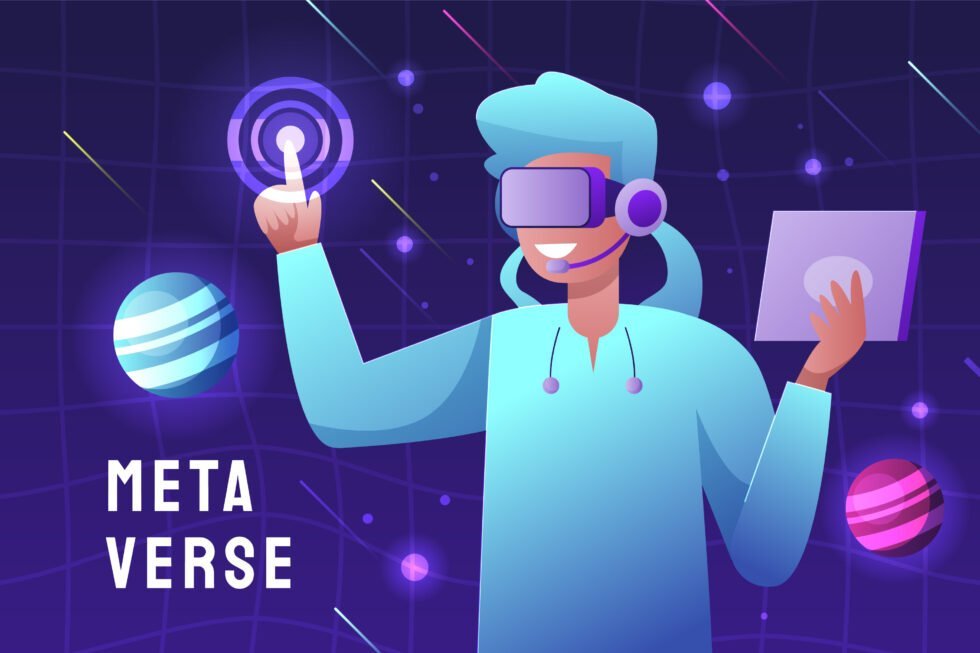Teaching and learning methods have come a long way, from studying in groups under the shade of a tree to blackboards to zoom meetings. However, if you think that zoom meetings were the furthest peak we could reach, this article is worth a read! Metaverses are in vogue and it was not long enough before the world of education also logged into it. As the generations of students change with the evolving technologies, teaching methods must evolve too. Education in the metaverse is gradually making its way into students’ lives and is poised to become a staple for teaching students most efficiently.
THE CONCEPT OF METAVERSE

The metaverse is a 3D virtual world that blends online gaming, VR, AR, and social media where users can interact virtually. It is a perpetual, active, and real-time verse. It conquers limitations brought forward by geographical boundaries to offer beneficial services to clients. This virtual world is the perfect space for shopping, socializing, learning, shopping and business too.
The metaverse is a digital landscape where users can create their virtual environments. Moreover, users can also connect in a way that is more personal than other methods. The metaverse presents an innovative method of virtually interacting with others around the world. Just put on your virtual reality headset and log into a virtual world and communicate with anyone from anywhere.
Just think of the metaverse as a virtual version of the world we live in. A place where developers and users can create anything from virtual arenas to metaverse schools. In a world that is becoming more and more geographically divided, the metaverse is the perfect way to travel around and learn new things

WHY IS THE METAVERSE A GREAT EDUCATIONAL PLATFORM?

Unlike zoom meetings which are considered over once you log out or disconnect from a meeting, the metaverse is always “on.” We have come a long way from a conventional blackboard and PC teaching. 3D animations have become a staple for understanding concepts and these animations must be used in an immersive and interactive manner.
Metaverses can serve as very efficient educational platforms due to a variety of reasons.
VISUALIZE AND TELL STORIES TO EXPLORE DIVERSE WORLDS.

Visualization and storytelling are trademarks of metaverse learning, much needed after dull COVID Zoom sessions. Learners can use VR to step into a different environment or someone else’s shoes for a unique and immersive experience. DaVita, for example, uses an interactive, multi-sensory first-person story to enhance patient empathy.
Entering meta worlds makes it easier to visualize circumstances, including difficult development challenges. A learner, for example, can use a VR headset to investigate a street makeover in Africa or to experience life in a green Smart City. Learners “enter” critical global development concerns such as climate change, education, gender, urban development, and international trade through bite-sized 360-degree storytelling, virtual tours, and visualizations.
MAKE IT EASIER FOR THOSE WITH IMPAIRMENTS TO GET AROUND.

The metaverse has the potential to increase educational and social opportunities for those with impairments. An immersive environment, for example, allows young adults with special needs, autism, and social interaction challenges to enhance their interpersonal and professional skills through activities such as visiting a mall or grocery store, shelving products at a store, or loading things into a truck. They can practice skills and engage with others in a safe setting using VR apps without feeling overwhelmed or scared.
INCREASE DATA COLLECTION ON LEARNING PERFORMANCE.

Using the metaverse to develop immersive learning experiences enables enterprises to acquire previously untapped data to obtain insights into learner behavior to track progress, discover gaps, and continuously enhance the learning experience. Usage, performance, attention and engagement, sentiment, and predictive analysis are examples of useful data about learner actions. Teachers can also take a more active part in gathering data and assessing lessons on the success of such learning settings. Pfizer’s and Bristol-Myers Squibb’s pharma simulators track hand movements, for example. If users cross their hands or angle them incorrectly under the biosafety cabinet, the sim quickly delivers feedback and restarts.
IMPROVE REAL-WORLD PROFICIENCY IN VIRTUAL AND HYBRID CONTEXTS

The metaverse offers immersive, embodied skilling chances through real-world scenarios and high-pressure settings in which mistakes can be made without repercussions. It mixes VR with data science and spatial design to boost learner engagement, confidence, and application when appropriately developed
Students can study via experimentation. Novant Health uses high-fidelity, multiplayer VR simulation to develop life-saving lab skills. Students enter a virtual lab where they can engage with teachers while practicing numerous medical procedures.
APPLICATIONS OF THE METAVERSE IN EDUCATION
A metaverse just doesn’t mean that a student will be roaming around in a virtual world. A metaverse offers a variety of methodologies for educating students. These methods are not only immersive but efficient and easy to understand as well.
DIGITAL LEARNING

The introduction of smart classes in school curricula has enhanced students’ understanding and learning of concepts. Similarly, the metaverse can make classrooms smarter by allowing students to understand theories with immersive 3D animations, helping them experience content in more detail. Moreover, it will provide students with a space to experiment, fail and learn from mistakes.
CREATING REAL-LIFE SIMULATIONS

Metaverse learning engages students by simulating real-life circumstances. This includes allowing them to conduct experiments, demonstrate prototypes, and enter documentary videos such as those about World War I. In the future, subject-specific 3D spaces may be produced to aid student learning and help professors better explain subject knowledge.
VIRTUAL 3D CLASSES

The rise of online classes in schools and universities has created a gap between immersive physical and virtual education. Bridging this gap can be achieved by creating 3D classrooms, enabling students to virtually interact with teachers and classmates. The metaverse learning system makes it possible for students from any geographical location to participate and engage in activities beyond a physical classroom.
VIRTUAL WORLDS

Imagine traveling to a specific place virtually instead of reading about it. Won’t that be terrific? By allowing students to travel to the spot they are learning about, the metaverse can help broaden their horizons and worldviews.
SPREADING AWARENESS

The metaverse can raise awareness of societal issues like famine, pollution, and climate change. This will aid in arousing students’ humanitarian interests. Documentaries about famine in Somalia or poverty in Burundi help students understand the impact on the people there. This teaching technique provides both theoretical and emotional knowledge.
APPLYING THE METAVERSE TO DIFFERENT SUBJECTS

GEOGRAPHY
Students studying geography and astronomy can explore the different layers of the earth or constellations through hyper-realistic 3D animations offered in a metaverse.
SCIENCE
Students can access laboratories and experiment in a virtual environment. For example, students can dissect a cadaver to learn anatomy or mix chemicals without having fear of accidental spills or hazards.
LITERATURE
Students can enter a metaverse and watch scenes of novels unfold. Therefore helping them understand the story and relate to the characters.
HISTORY
Any historical era can be recreated in a metaverse where students can visit that era and learn about it in a more immersive way.
LOGGING OUT
In short, emerging technologies have become a great enabler for the education industry. The metaverse is a brand-new concept in education, compared to existing technologies. As discussed above, the metaverse can bring about a lot of innovation in the education sector.
Technology shapes the way we teach and learn, facilitating education and breaking barriers. Using the metaverse in education could bring about other exciting changes worth exploring.










 (03KEUPK4394K1ZN)
(03KEUPK4394K1ZN)